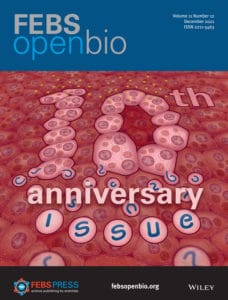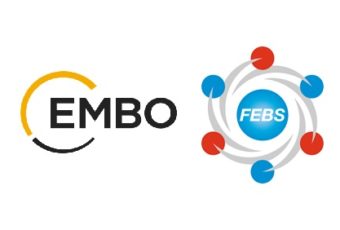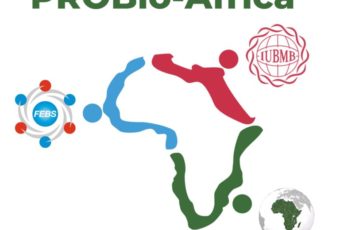 FEBS Open Bio, the youngest of the four FEBS Press journals, is celebrating its 10th anniversary this month. To mark this milestone, the journal has published a special anniversary issue, comprising editorials, reviews and research articles, all especially commissioned for the occasion. Eight members of the journal’s prestigious editorial board contributed review and research articles on a diverse range of subjects. In addition, this issue includes the latest research by the authors of some of the most highly cited articles published in the journal in the last decade.
FEBS Open Bio, the youngest of the four FEBS Press journals, is celebrating its 10th anniversary this month. To mark this milestone, the journal has published a special anniversary issue, comprising editorials, reviews and research articles, all especially commissioned for the occasion. Eight members of the journal’s prestigious editorial board contributed review and research articles on a diverse range of subjects. In addition, this issue includes the latest research by the authors of some of the most highly cited articles published in the journal in the last decade.
The journal invites you all to join the celebrations by checking out the contents of this issue below. We are sure there is something to interest everyone in the virtual pages of the issue, and thank all of our authors, reviewers, editors and authors for a very successful and productive decade!
Editorials:
- Ten years of FEBS Open Bio
Duncan E. Wright and Miguel A. De la Rosa
In this editorial, the journal’s Editor-in-Chief and Editorial Manager summarise the history of the journal and introduce the contents of the 10th anniversary issue. - FEBS Open Bio: past, present, and future
Duncan E. Wright, Felix M. Goni, Mary Purton, Laszlo Fesus, Johannes Buchner, John Mowbray and Miguel A. De la Rosa
In celebration of the 10th anniversary issue of FEBS Open Bio, we spoke to some of the key figures of the journal’s genesis, development, and its future direction, and recount here their thoughts and experiences. - Learning objectives: an epiphany
Priscilla Soulié and Pierre Cosson
An editorial describing the use of learning objectives in the creation of a new Bachelor-Master curriculum in Biomedical Sciences at the University of Geneva in 2017, which will be of enormous interest to all educators.
Review articles:
- The structure of gangliosides hides a code for determining neuronal functions
Giulia Lunghi, Maria Fazzari, Erika Di Biase, Laura Mauri, Elena Chiricozzi, Sandro Sonnino
Sandro Sonnino and colleagues at the University of Milano discuss the beginnings of the elucidation of a ganglioside ‘code’ which may regulate the physiological function of neurons, linking complex neuronal functions with biochemical diversity. - Evolution of memory system-related genes
Amal Bajaffer, Katsuhiko Mineta, Takashi Gojobori
Takashi Gojobori and colleagues at King Abdullah University of Science and Technology (KAUST) provide a broad overview of the molecular and physiological bases for memory, as well as our current understanding of its evolution. - Identifying sources of metabolomic diversity and reconfiguration in peach fruit: taking notes for quality fruit improvement
María F. Drincovich
The beginning of the peach season at the Universidad Nacional de Rosario in Argentina “bore fruit” with Maria F. Drincovich’s review of metabolic diversity and reconfiguration in peach fruit. - Transcriptional repression shapes the identity and function of tissue macrophages
Krisztian Bene, Laszlo Halasz, Laszlo Nagy
Laszlo Nagy and colleagues at Johns Hopkins All Children’s Hospital, Florida and the University of Debrecen review transcriptional repressors that modulate macrophage function and development. - A brief overview of BNIP3L/NIX receptor-mediated mitophagy
Mija Marinković and Ivana Novak
This mini-review by Ivana Novak and colleagues at the University of Split describes the role of the mitophagy receptor BNIP3L/NIX in the development of certain cell types. - The interplay between pathogens and Atg8 family proteins: thousand-faced interactions
Dávid Tóth, Gábor V. Horváth and Gábor Juhász
Gábor Juhász and colleagues at Eötvös Loránd University describe the use of prediction software to identify LIR motifs within SARS-CoV-2 proteins and Atg9 proteins. This offers a timely example of xenophagy in terms of the interactions between proteins of different pathogens. - Molecular mechanisms of the influenza fusion peptide: Insights from experimental and simulation studies
Diana Lousa and Cláudio M. Soares
Diana Lousa and Cláudio M. Soares of NOVA University Lisbon review findings of experimental and computational studies of the influenza fusion peptide structure, mode of action, and key residues. - Bacterial phospholipases C with dual activity: phosphatidylcholinesterase and sphingomyelinase
Laura Monturiol-Gross, Fabian Villalta-Romero, Marietta Flores-Díaz, Alberto Alape-Girón
Alberto Alape-Girón and colleagues at Universidad de Costa Rica and Instituto Tecnológico de Costa Rica discuss structural aspects of bacterial phospholipase C proteins which exhibit dual enzymatic activities.
Research articles:
- Extracellular RNA transfer from non-malignant human cholangiocytes can promote cholangiocarcinoma growth
Yu Ota, Kenji Takahashi, Shin Otake, Yosui Tamaki, Mitsuyoshi Okada Irene Yan, Kazunobu Aso, Satoshi Fujii, Tushar Patel, Masakazu Haneda
Tushar Patel et al. show extracellular vesicles can promote the growth of cholangiocarcinoma through the transfer of microRNA. - Caffeic acid: an antioxidant with novel antisickling properties
Tigist Kassa, James G. Whalin, Mark P. Richards and Abdu I. Alayash
Abdu I. Alayash et al. report on antisickling properties of the antioxidant caffeic acid with potential for sickle cell disease treatment. - Improvement of image resolution by combining enhanced confocal microscopy and quantum dot triexciton imaging
Simon Hennig, Dietmar J. Manstein
Dietmar Manstein and his colleague Simon Hennig of Hannover Medical School demonstrate quantum dot triexciton imaging with laser scanning microscopy can increase lateral and axial resolution. - Structural and functional insights into lysine acetylation of cytochrome c using mimetic point mutants
Inmaculada Márquez, Gonzalo Pérez-Mejías, Alejandra Guerra-Castellano, José Luis Olloqui-Sariego, Rafael Andreu, Juan José Calvente, Miguel A. De la Rosa, Irene Díaz-Moreno
Irene Díaz-Moreno and colleagues at the University of Seville report that acetylation of lysines 8 and 53 in cytochrome c are crucial for thermal stability and function, illuminating cytochrome c extra-mitochondrial roles.

